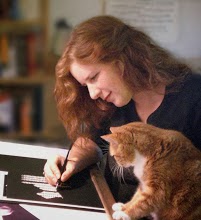There are many things that fascinate me - some visually, some emotionally, some intellectually. I subscribe to the Singularity Hub newsletter and enjoy browsing IFL Science when I can, as both of those sites generally stimulate and sate my intellectual curiosity. But sometimes things that I stumble across in those places satisfy multiple curiosities at once, and Google's Deep Dream is one of them. It invokes the same fascination I have for fractal images and architectural drawings... while also making me wonder what it would be like to try LSD.
If you haven't heard of it I'll give you a layperson's rundown (I really have no idea what I'm talking about, so if you want the real scoop read this great blog post). My understanding is that the ongoing quest to develop AI that can recognize images (not just match pixels but actually interpret the image) is part of a broader area of research into artificial neural networks (the underpinnings of true computer learning). When they train an artificial neural network to recognize a certain thing they show it tonnes of different images of the thing and it, not unlike the way the human brain does, interprets what it 'sees' through various stages of recognition (shapes, lines, then associations with other structures, etc) to learn what the target thing is.
They can test how this training is going by giving the computer some 'noise' (random pixels of color) and asking the neural network to visualize the thing they are trying to train it to, it will show what it has learned and you can see how on-target that is to the images you want it to be looking for. Basically this strategy shows researchers the difference between what they are teaching and what is actually being learned (as a teacher I have come to appreciate very much the gap that can exist between those two things and how important it is!).
So here's the fun part. For the Deep Dream Generator Google has created a website that allows you to upload images to their neural network (one not trained for any particular image, I believe) and it is set to visualize what it perceives in the image. The results are freaky and intriguing and sometimes beautiful... the digital painting that I posted in the last blog post looks like this after being run through Deep Dream:
Come on - tell me that isn't awesome.. and creepy...
I think this whole thing taps into the same wonder I feel watching someone look at a piece of my art - especially if it's not a photorealistic piece. Is the subject sad or tired, or just contemplative? What are they feeling? What does the atmosphere feel like? What just happened? What is about to happen?
Each person views an image through their own filter and sees the piece a little bit differently - and looking at Deep Dream's images shows what feels like an alien, yet somehow weirdly familiar, kind of visual filter.
It also makes me feel like there are hidden chimeric animals all around me. And really - invisible gerbilfish just can't help but make the world a bit more awesome, amiright?
Tuesday, April 26, 2016
Subscribe to:
Post Comments (Atom)






1 comment:
youareright! Awesome definitely! Love the gerbilfish! I love how art creates the sense of seeing the invisible, it's like seeing what you feel. The following pic "turned my back on you" with this gerbilfish really go hand in hand. I agree with the feeling of the invisible alien yet the familiar that surrounds us and has a being. The sense that there is a watching, a seeing of us but a not seeing of them. The natural interaction of human to animal is looking at each other. Communication is often not offered but seeing is. The gerbilfish see us but we turn our back on seeing them. Sad, tired, contemplative all describe the emotions that can diminish the eye that can discern the invisible, the spiritual, the creative unique feelings that lie outside the box.
Wonderful Pam!
cab
Post a Comment